
Who was Abu Bakr al-Baghdadi?
[ad_1]
 AFP
AFPAbu Bakr al-Baghdadi, the leader of the jihadist group Islamic State (IS) and arguably the world’s most wanted man, killed himself during a raid by US commandos in north-western Syria, President Donald Trump has said.
The self-styled “Caliph Ibrahim” had a $25m (£19m) bounty on his head and had been pursued by the US and its allies since the rise of IS five years ago.
At its peak, IS controlled 88,000 sq km (34,000 sq miles) of territory stretching from western Syria to eastern Iraq, imposed its brutal rule on almost eight million people, and generated billions of dollars in revenue from oil, extortion and kidnapping.
But despite the demise of its physical caliphate and its leader, IS remains a battle-hardened and well-disciplined force whose enduring defeat is not assured.
‘The believer’
Baghdadi – real name Ibrahim Awwad Ibrahim al-Badri – was born in 1971 in the central Iraqi city of Samarra.
His religious Sunni Arab family claimed to be descended from the Prophet Muhammad’s Quraysh tribe – something generally held by pre-modern Sunni scholars as being a key qualification for becoming a caliph.
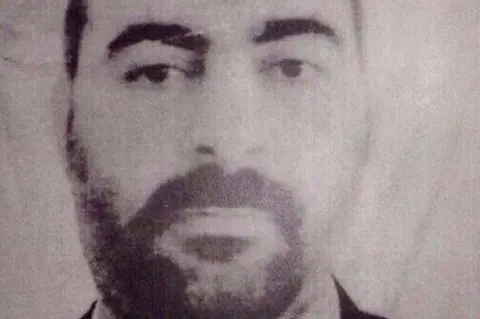 AFP
AFPAfter finishing school in the early 1990s he moved to the capital, Baghdad. He gained bachelor’s and master’s degrees in Islamic studies before embarking on a PhD at the Islamic University of Baghdad, according to a biography published by supporters.
While a student, he lived near a Sunni mosque in Baghdad’s north-western Tobchi district. He is said to have been a quiet man who kept to himself, except for when he taught Koranic recitation and played football for the mosque’s club. Baghdadi is also believed to have embraced Salafism and jihadism during this time.
‘Jihadist university’
In early 2004, Baghdadi was detained by US troops in the city of Falluja, west of Baghdad, and was taken to a detention centre at Camp Bucca in the south.
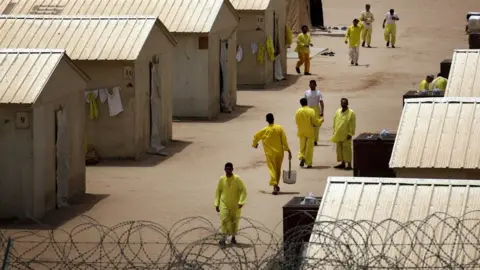 AFP
AFPRebuilding al-Qaeda in Iraq
After leaving Camp Bucca, Baghdadi is believed to have come into contact with the newly formed al-Qaeda in Iraq (AQI). Under the leadership of the Jordanian Abu Musab al-Zarqawi, AQI became a major force in the Iraqi insurgency and gained notoriety for its brutal tactics, including beheadings.
In early 2006, AQI created a jihadist umbrella organisation called the Mujahideen Shura Council, which Baghdadi’s group pledged allegiance to and joined.
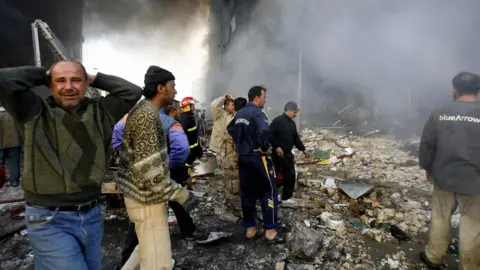 AFP
AFPLater that year, following Zarqawi’s death in a US air strike, the organisation changed its name to the Islamic State of Iraq (ISI). Baghdadi supervised the ISI’s Sharia committees and joined its consultative Shura Council.
When ISI’s leader Abu Umar al-Baghdadi died in a US raid in 2010 along with his deputy Abu Ayyub al-Masri, Abu Bakr al-Baghdadi was named his successor.
He inherited an organisation that US commanders believed to be on the verge of a strategic defeat. But with the help of several Saddam-era military and intelligence officers, among them fellow former Camp Bucca inmates, he gradually rebuilt ISI.
‘Caliph Ibrahim’
By early 2013, it was once again carrying out dozens of attacks a month in Iraq. It had also joined the rebellion against President Bashar al-Assad in Syria, sending Syrian militants back from Iraq to set up the al-Nusra Front as al-Qaeda’s affiliate in the country. There, they found a safe haven and easy access to weapons.
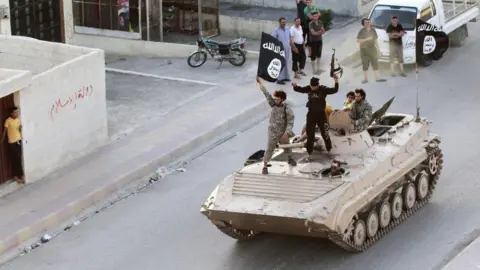 Reuters
ReutersThat April, Baghdadi announced the merger of his forces in Iraq and Syria and the creation of “Islamic State in Iraq and the Levant” (Isis/Isil). The leaders of al-Nusra and al-Qaeda rejected the move, but fighters loyal to Baghdadi split from al-Nusra and helped Isis remain in Syria.
At the end of 2013, Isis shifted its focus back to Iraq and exploited a political stand-off between the Shia-led government and the minority Sunni Arab community. Aided by tribesmen and former Saddam Hussein loyalists, Isis overran Falluja.
In June 2014, several hundred Isis militants overran the northern city of Mosul, routing the Iraqi army, and then advanced southwards towards Baghdad, massacring their adversaries and threatening to eradicate the country’s many ethnic and religious minorities.
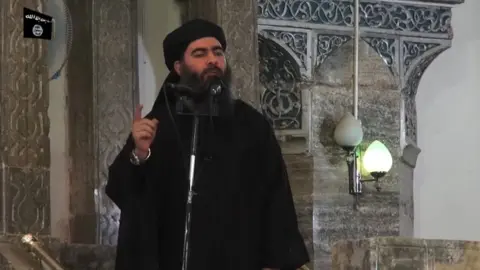 AFP
AFPAt the end of the month, after consolidating its hold over dozens of Iraqi cities and towns, Isis declared the creation of a “caliphate” – a state governed in accordance with Sharia by a caliph – and renamed itself “Islamic State”. It proclaimed Baghdadi as “Caliph Ibrahim” and demanded allegiance from Muslims worldwide.
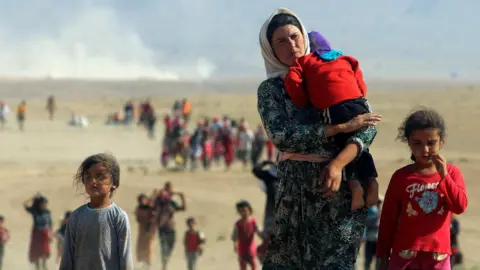 Reuters
ReutersJust over a month later, IS militants advanced into areas controlled by Iraq’s Kurdish ethnic minority and killed or enslaved thousands of members of the Yazidi religious group.
The atrocities against the Yazidis, which UN human rights investigators said constituted the crime of genocide, prompted a US-led multinational coalition to launch an air campaign against the jihadists in Iraq. It started conducting air strikes in Syria that September, after IS beheaded several Western hostages.
Attacks in other countries also began to be attributed to IS or individuals it inspired. Such attacks – including the downing of a Russian airliner over Egypt’s Sinai peninsula in October 2015, the Paris attacks that November, and the Sri Lanka suicide bombings in April 2019 – have claimed several thousand lives since 2014.
IS defeated
Once the US-led coalition intervened, IS began to be slowly driven out of the territory it controlled.
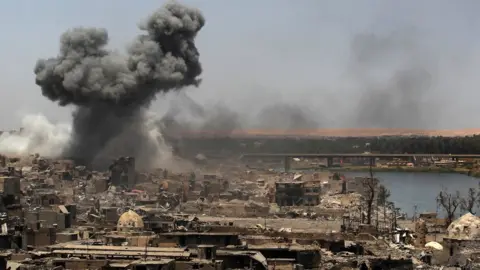 AFP
AFPThe ensuing war left many thousands of people dead across the two countries, displaced millions more, and devastated entire areas.
In Iraq, federal security forces and Kurdish Peshmerga fighters were supported by both the US-led coalition and a paramilitary force dominated by Iran-backed militias, the Popular Mobilisation (al-Hashd al-Shaabi).
In Syria, the US-led coalition backed an alliance of Syrian Kurdish and Arab militias, the Syrian Democratic Forces (SDF), and some Syrian Arab rebel factions in the southern desert. Troops loyal to President Assad meanwhile also battled IS with the help of Russian air strikes and Iran-backed militiamen.


Throughout the fighting the question of whether Baghdadi was dead or alive remained a source of mystery and confusion.
But that September IS released an audio message apparently from Baghdadi that included a call for the group’s followers to “fan the flames of war on your enemies”.
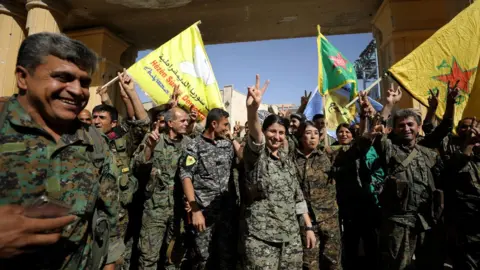 Reuters
ReutersSuch exhortations were not enough to stop SDF fighters capturing Raqqa the following month and driving its supporters into sparsely populated desert areas.
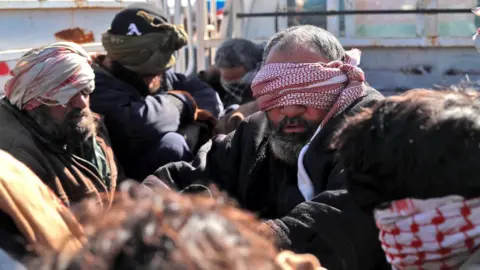 AFP
AFPIn March 2019, the last piece of territory held by IS in Syria, near the village of Baghuz, was captured by the SDF, bringing a formal end to Baghdadi’s “caliphate”.
‘Battle of attrition’
IS was thought to still have thousands of armed supporters in the region, many of them operating in sleeper cells. In Iraq, they were already carrying out attacks in an attempt to undermine the government’s authority, create an atmosphere of lawlessness, and sabotage reconciliation and reconstruction efforts.
He acknowledged his group’s losses and said IS was now waging a “battle of attrition”, urging supporters to launch attacks to drain its enemies’ human, military, economic, and logistical resources.
It was not clear when or where the video was recorded, but Baghdadi seemed to be in good health. He was seen sitting with at least three other men whose faces were masked or blurred, and going through files on IS branches elsewhere in the world.
Analysts saw it as an attempt by Baghdadi to assert that he was still in charge.
No more was heard from him until September, when IS released a purported audio message in which he said “daily operations” were under way on “different fronts”.
He also called on supporters to free the thousands of suspected IS militants and tens of thousands of women and children linked to IS who were detained at SDF-run prisons and camps in Syria following the fall of Baghuz.
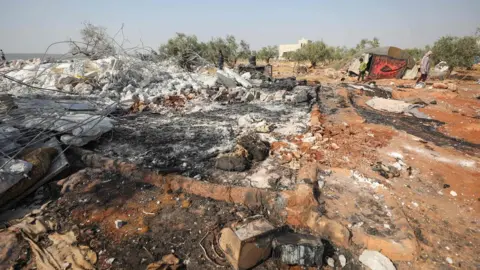 AFP
AFPMore than 100 prisoners escaped during the offensive and IS sleeper cells carried out several attacks, but Mr Trump rejected criticism of the US withdrawal. “Turkey, Syria, and others in the region must work to ensure that [IS] does not regain any territory,” he insisted. “It’s their neighbourhood; they have to maintain it.”
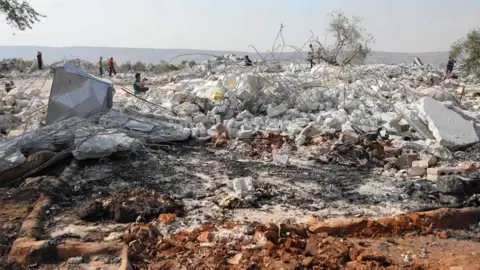 AFP
AFPPresident Trump later told reporters that Baghdadi retreated into a tunnel with three of his children during the raid and then detonated an explosive vest when US military dogs were sent in, killing himself and the children. Baghdadi’s body was mutilated by the blast, but test results gave certain and positive identification, he said.
“A brutal killer, one who has caused so much hardship and death, was violently eliminated – he will never again harm another innocent man, woman or child,” Mr Trump declared. “He died like a dog. He died like a coward. The world is now a much safer place.”
There was no immediate confirmation of Baghdadi’s death from IS.
[ad_2]
Source link





